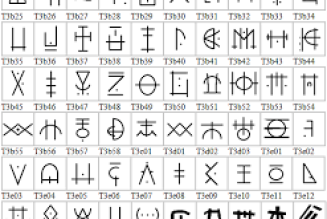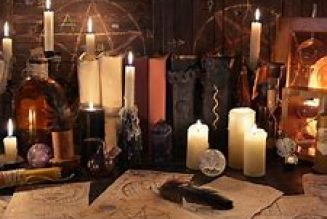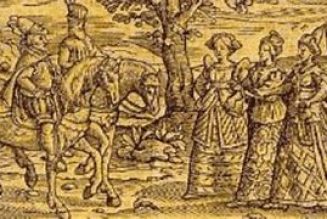The expulsion of evil spirits by commanding them to depart.
The expulsion is often done in the name of a deity, saints, angels or other intercessory figures.
Exorcism comes from the Greek horkos, meaning “oath,” and translates as adjuro, or adjure, in Latin and English.
To “exorcize,” then, does not really mean to cast out so much as it means “putting the Devil on oath,” or invoking a higher authority to compel the Devil to act in a way contrary to its wishes.
Such compulsion also implies binding.
The Anglican pamphlet Exorcism (1972) states, “Christian exorcism is the binding of evil powers by the triumph of Christ Jesus, through the application of the power demonstrated by that triumph, in and by his Church.”
Exorcism rituals often begin with the Latin words, “Adjure te, spiritus nequissime, per Deum omnipotentem,” which translates as “I adjure thee, most evil spirit, by almighty God.”
Jesus, who cast out devils, did not exorcise, because he did not need to call on any higher authority than Himself.
Violence both physical and spiritual often dominates an exorcism.
Furniture bangs and breaks, waves of heat Priest exorcising demon from possessed woman and cold pour over the room, horrible cries emanate from the victim and often the victim suffers real physical pain and distress.
The Devil seems to revel in spitting, vomiting and other, more disgusting bodily functions as well.
Spiritually, the Devil and the exorcist battle for the soul of the victim, and while the Devil hurls invectives, the exorcist counters with the strongest demands for the demon’s departure, vowing pain and penalty if it does not comply.
Exorcisms may also include the physical beating of a sufferer to force the demon to depart, or throwing stones at the possessed person.
In extreme cases, such as that of Urbain Grandier in Loudun, the possessed person is killed and burned, or even burned alive, to remove all traces of the Devil’s evil.
Such punishments imply that the exorcist does not believe the victim suffered innocently at the hands of the Devil, but rather that in some say he or she invited trouble.
As late as 1966, members of a fanatic cult in Zurich, Switzerland, ritually beat a young girl to death for being “the Devil’s bride.”
Priests and ministers perform most exorcisms, but clairvoyants and spiritualists also expel evil spirits.
The ritual is not nearly as important as the exorcist himself (or herself); such talent is a gift that should be developed.
The exorcist must be convinced of the victim’s possession and have faith in the power of the Lord to work through the exorcist.
In his book Hostage to the Devil (1976), former Jesuit professor Malachi Martin describes the typical exorcist:
Usually he is engaged in the active ministry of parishes.
Rarely is he a scholarly type engaged in teaching or research.
Rarely is he a recently ordained priest.
If there is any median age for exorcists, it is probably between the ages of fifty and sixty-five.
Sound and robust physical health is not a characteristic of exorcists, nor is proven intellectual brilliance, postgraduate degrees, even in psychology or philosophy, or a very sophisticated personal culture.
Though, of course, there are many exceptions, the usual reasons for a priest’s being chosen are his qualities of moral judgment, personal behavior, and religious beliefs—qualities that are not sophisticated or laboriously acquired, but that somehow seem always to have been an easy and natural part of such a man.
The exorcist as victim. Although most accounts of exorcism concentrate on the sufferings of the victim and the machinations of the Devil, little has been said about the effect on the exorcist.
Yet an exorcist assumes a heavy risk when fighting evil.
Not only can the ordeal go on for weeks, maybe months, but the exorcist must be prepared to have his entire life bared by the paranormal knowledge of the Devil.
Secret sins are blurted out and ridiculed, and the demons may even mimic the voices of long-lost loved ones.
Becoming possessed himself ranks as the greatest danger to the exorcist, especially if he suffers from guilt and secretly feels the need to be punished.
Father Jean-Joseph Surin, Jesuit exorcist to the nuns at Loudun, became possessed while ministering to Jeanne des Anges after the death of Grandier.
Reared in a cloister, Surin practiced self-denial during his early years as a priest, denying himself food, sleep and social contact.
By the time he went to Loudun, Surin suffered from poor health, severe headaches, muscle pain, melancholy and attacks of depression and confusion.
Unlike many of his fellow Jesuits, Surin firmly believed that Sister Jeanne and the others were truly possessed.
On January 19, 1635, Surin experienced his first possession, and by January 7 of the next year, the demon Isacaaron—devil of lust and debauchery—had left Sister Jeanne and entered Father Surin.
Leviathan and other demons also tortured the priest.
In May 1635 Father Surin wrote of his torments to his friend Father Datichi, a Jesuit in Rome:
Things have gone so far that God has permitted, for my sins, I think, something never seen, perhaps, in the Church: that during the exercise of my ministry, the Devil passes from the body of the possessed person, and coming into mine, assaults me and overturns me, shakes me, and visibly travels through me, possessing me for several hours like an energumen.
Some say that it is a chastisement from God upon me, as punishment for some illusion; others say something quite different; as for me, I hold fast where I am, and would not exchange my fate for anyone’s, being firmly convinced that there is nothing better than to be reduced to great extremities.
Surin continued to be ill and tormented throughout 1637 and 1638, and by 1639 he could no longer dress himself, eat without difficulty, walk or read and write.
In 1645 Surin attempted suicide.
He would have probably died had not the kindly Father Bastide taken over as head of the Jesuit College at Saintes, where Surin lived, in
Sixteen Forrty Eight.
He brought Surin back to health step by step, giving him the love and attention Surin had never experienced.
Eventually Father Surin was able to walk again, and to read and write; he even attained enough inner strength to preach and hear confession.
He wrote of his experiences at Loudun in his memoirs, Science Experimentale, and finally died, peacefully, in 1665.








